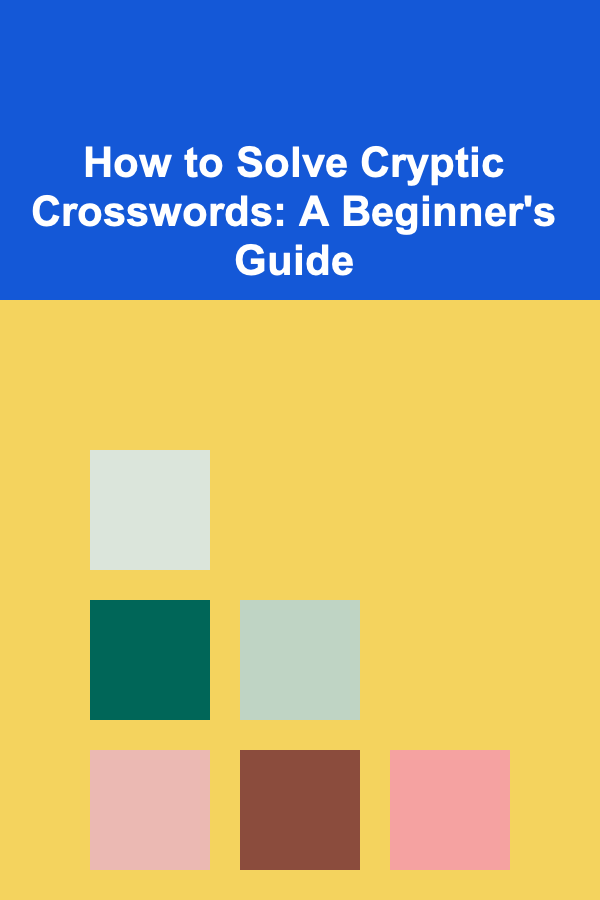
How to Solve Cryptic Crosswords: A Beginner's Guide
ebook include PDF & Audio bundle (Micro Guide)
$12.99$6.99
Limited Time Offer! Order within the next:

Cryptic crosswords have long been a beloved pastime for puzzle enthusiasts. Unlike their simpler counterparts, these crosswords are filled with complex wordplay and obscure clues that can seem like a code to decipher. But once you understand the rules and techniques behind solving them, cryptic crosswords can become an incredibly rewarding and intellectually stimulating hobby.
In this guide, we'll break down the fundamentals of cryptic crosswords, explain how to approach them, and provide tips to help beginners solve their first puzzles. Whether you're a curious beginner or someone who wants to refine your skills, this guide will set you on the right path to mastering cryptic crosswords.
What is a Cryptic Crossword?
A cryptic crossword is a type of crossword puzzle in which each clue is a word puzzle in itself. These clues are made up of two parts: a definition and a wordplay component. The definition is typically a straightforward description of the answer, while the wordplay involves various linguistic tricks, such as anagrams, homophones, abbreviations, and hidden words. Cryptic crossword clues often involve a combination of logic, knowledge of the English language, and lateral thinking.
Key Characteristics of Cryptic Clues
- Two-Part Clues: Every cryptic clue consists of two parts: the definition and the wordplay. The definition typically comes at the beginning or end of the clue, while the wordplay makes up the rest.
- Wordplay : Wordplay is the puzzle-solving element of cryptic clues. It can involve a variety of tricks like:
- Anagrams: Rearranging letters of a word or phrase.
- Homophones: Words that sound alike but have different meanings.
- Hidden Words: Words concealed within other words.
- Abbreviations: Shortened forms of words or phrases.
- Containers and Reversals: A word hidden inside another, or the letters of a word in reverse order.
Common Types of Cryptic Clue Wordplay
Cryptic crossword clues use a range of wordplay mechanisms, each requiring a unique approach. Below are the most common types you'll encounter:
1. Anagrams
An anagram clue suggests that the solution can be found by rearranging the letters of another word or phrase. These clues often include indicators like "scrambled," "mixed," "shuffled," or "confused," to signal that an anagram is involved.
Example:
- Clue: Scrambled meat from a butcher (5)
- Solution: TENDER (An anagram of "meat")
2. Homophones
Homophones are words that sound the same but have different meanings or spellings. Clues for homophones often include indicators such as "sounds like," "we hear," "audibly," or "on the radio."
Example:
- Clue: Dog's bark sounds like a tree (3)
- Solution: BAY (Homophone of "bay," meaning both a dog's bark and a type of tree)
3. Hidden Words
A hidden word clue involves finding the answer within the letters of the clue itself. The answer is typically "hidden" within a continuous sequence of letters, and the clue will contain words like "inside," "within," or "part of."
Example:
- Clue: A full plate has a hidden prize (5)
- Solution: PLATE (Hidden in "a full plate")
4. Abbreviations
Cryptic crosswords often use abbreviations to represent words. These abbreviations might refer to common phrases, such as "Dr." for "Doctor," or "NB" for "nota bene" (note well). The clue may directly reference an abbreviation or require you to recognize it within the wordplay.
Example:
- Clue: Doctor's examination reveals a bit of wisdom (3)
- Solution: GEM (G (abbreviation for "doctor") + "EM" (examination))
5. Containers and Reversals
In container clues, part of the answer is "contained" within another word. Reversal clues involve words that are read backward. These can be tricky, but with practice, you'll get the hang of recognizing these types of clues.
Example of Container Clue:
- Clue: Tiny animals inside big container (7)
- Solution: MICE (Hidden inside "bimicecontainer")
Example of Reversal Clue:
- Clue: Start to reverse an error (5)
- Solution: REACT (Reverse "CART" from "error")
Tips for Solving Cryptic Crosswords
For beginners, cryptic crosswords can be a challenging, but highly rewarding puzzle-solving experience. Here are some practical tips to help you get started and improve your solving skills:
1. Start with the Definitions
The definition part of a cryptic clue is usually the easiest part to identify. It's often at the beginning or end of the clue and will be a straightforward description of the answer. Start by trying to solve the clue's definition first, as it will give you a sense of the possible answer and help you work out the wordplay.
Example:
- Clue: Dramatic act (6)
- Solution: ACTOR (The definition is straightforward---an actor is someone who performs a dramatic act)
2. Look for Clue Indicators
Clue indicators are words that signal a specific type of wordplay. Pay attention to these words, as they can help you determine the wordplay technique involved. For example, "scrambled" suggests an anagram, and "sounds like" hints at a homophone.
3. Use Letter Combinations
If you're stuck on a clue, use the letters you already know from other answers. You may be able to infer letters in the unsolved clues, narrowing down the possibilities. Many crossword puzzle solvers will try to fill in the grid with letters that fit, allowing you to work out possible combinations.
4. Break Down the Clue into Two Parts
It's often useful to break down a cryptic clue into its two parts: the definition and the wordplay. Try to identify the definition first, then focus on interpreting the wordplay. Sometimes the wordplay component will provide you with enough information to deduce the definition.
5. Practice Makes Perfect
Cryptic crosswords require practice. As you solve more puzzles, you'll start to recognize patterns in the clues, and your solving skills will improve. Don't get discouraged if you can't solve a puzzle immediately. Try to complete smaller sections and build from there.
6. Don't Be Afraid to Use Online Resources
There's no shame in consulting a dictionary or an online crossword solver for help when you're stuck. Cryptic crossword clues often involve obscure references or difficult vocabulary. If you're struggling with a particular clue, don't hesitate to look up unfamiliar terms.
Example of Solving a Cryptic Clue Step by Step
Let's go through an example clue to demonstrate how to solve it.
Clue : Hurt someone with iron (4)
- Identify the definition: The definition is likely "hurt," as it's the most straightforward part of the clue.
- Look for wordplay: The wordplay seems to involve "someone" and "iron." We know that in cryptic crosswords, "iron" is often abbreviated to "Fe" (from the chemical symbol for iron).
- Work through the wordplay: "Someone" could be a synonym for a person or a character. The wordplay could involve adding "Fe" (iron) to the beginning of a word for someone.
- Solution : The answer is FEEL (which means to hurt or feel pain, and "Fe" is added to "EL" (someone)).
Practice Puzzle for Beginners
To get started with solving cryptic crosswords, try this practice clue:
Clue : Makes a mess of cake? (7)
Take your time working through it, identifying the definition and wordplay, and see if you can come up with the solution.
Conclusion
Cryptic crosswords may seem daunting at first, but with practice, patience, and a methodical approach, they can become an enjoyable and rewarding challenge. Remember that each clue contains both a definition and a wordplay component, and mastering common wordplay types will greatly enhance your solving skills.
As you practice and familiarize yourself with cryptic crossword conventions, you'll find that the puzzles become more intuitive. So grab your pencil, start with a few beginner puzzles, and keep working through the clues---soon you'll be solving cryptic crosswords like a pro. Happy puzzling!
Reading More From Our Other Websites
- [Organization Tip 101] Common Mistakes to Avoid When Using a Dryer Vent Cleaning Kit
- [Home Holiday Decoration 101] How to Plan a Cohesive Holiday Party Theme for Your Event
- [Home Security 101] How to Prevent Identity Theft by Securing Your Home's Paperwork
- [Home Soundproofing 101] How to Use Acoustic Panels for Better Soundproofing
- [Home Pet Care 101] How to Make Homemade Dog Treats with Limited Ingredients
- [Organization Tip 101] How to Organize Craft Supplies for Easy Access
- [Metal Stamping Tip 101] Best Ways to Integrate CNC Press Brakes with Automated Metal Stamping Lines
- [Organization Tip 101] How to Create a Cozy Reading Nook with Smart Organization
- [Personal Care Tips 101] How to Properly Dispose of Used Razor Blades
- [Organization Tip 101] How to Organize Kids' Toys Using the Toy Rotation Method

Business Intelligence Analyst's Handbook: Strategies for Building Effective Dashboards and Reports
Read More
Effective Strategies for Lowering Rental Insurance Premiums Without Sacrificing Coverage
Read More
How to Build a Checklist for Leveraging Content Marketing in Event Promotion
Read More
How to Set Up a Kid-Friendly Dining Area
Read More
How to Store Paints and Brushes for Kids' Projects
Read More
How to Build Financial Models for Profit Projection
Read MoreOther Products

Business Intelligence Analyst's Handbook: Strategies for Building Effective Dashboards and Reports
Read More
Effective Strategies for Lowering Rental Insurance Premiums Without Sacrificing Coverage
Read More
How to Build a Checklist for Leveraging Content Marketing in Event Promotion
Read More
How to Set Up a Kid-Friendly Dining Area
Read More
How to Store Paints and Brushes for Kids' Projects
Read More